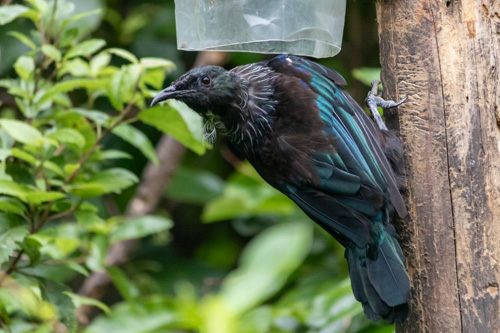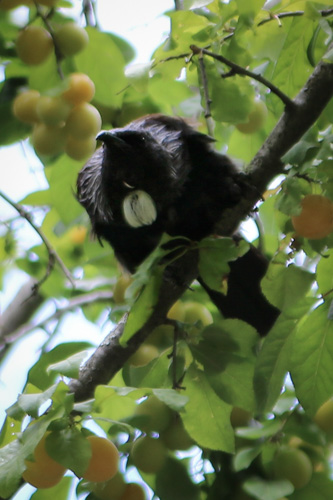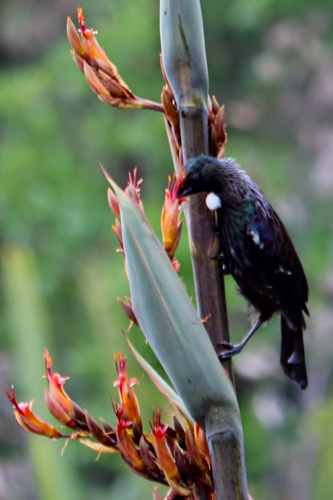The Tui Bird of New Zealand: Nature's Enigmatic Maestro
The Tui | Tūī (Prosthemadera novaeseelandiae) is a remarkable and iconic bird native to New Zealand, known for its distinctive appearance, enchanting song, and fascinating behaviour.
This avian species is a member of the honey-eater family, and it holds a special place in New Zealand's cultural and ecological landscape.

Scientific Name: Prosthemadera novaeseelandiae. Family: Meliphagidae
Other Names:
The Tui | Tūī, known scientifially as Prosthemadera novaeseelandiae, is primarily referred to by its common name, but it also has a few other regional or colloquial names in New Zealand:
- Koko: In some parts of New Zealand, especially among Maori communities, the Tui is known as "koko."
- Poi Bird: The term "poi" refers to the Tui's white throat tuft or wattle, and thus, it is sometimes called the "Poi Bird."
- Parson Bird: This name is derived from the Tui's distinctive white collar of feathers, which has a clerical or parson-like appearance.
These names reflect the bird's distinctive features and cultural significance in New Zealand.
Geographical variation recognised subspecies:
Tui P. n. novaeseelandiae (Not Vulnerable)
Chatham Island Tui P. n. chathamensis (Nationally Vulnerable).
Tui Physical Characteristics Description and Identification
Tui, ngā tūī, are medium-sized birds, measuring about 30 centimetres (12 inches) in length. Tui are easily recognisable due to their glossy, iridescent plumage, which exhibits shades of metallic green and blue, contrasting with a white tuft of feathers at their throat.
These striking colours are particularly vivid when illuminated by sunlight. Tui also feature a small white crescent-shaped patch on each side of their neck, further enhancing their unique appearance.
You may also be interested in other New Zealand wildlife...
List of birds in New Zealand and a list of animals in New Zealand
Distinctive Features of New Zealand Tui Birds
Wattle
One of the most distinctive features of the native New Zealand Tui bird is its white tuft of feathers at the throat, called a "wattle" or "poi." It can puff up and become quite prominent during territorial displays or when the bird is excited. This wattle not only adds to the Tui's unique appearance but also plays a role in their social interactions.

Tui Iridescent Plumage
The iridescent plumage serves both for camouflage and visual communication. It allows Tui birds to blend into their surroundings while dazzling potential mates or rivals with their shimmering colours. When the sun's rays hit their feathers, they seem to transform into living gems, reflecting a spectrum of colours. The vibrant colours on a Tui bird's plumage aren't due to pigments, but microscopic structures that refract light.
Unique Tui Song
Tuis, ngā tūī, are renowned for their enchanting and complex songs. Their vocalisations consist of a wide range of melodious notes, clicks, and gurgles. These songs are often described as a symphony of sounds, rich in texture and tone.
Tui have a remarkable ability to mimic other birds and even some mechanical sounds, showcasing their extraordinary vocal versatility. Their repertoire includes imitations of bellbirds, parakeets, and even cell phone ring tones. This mimicry skill is a testament to their intelligence and adaptability.
Habitat, Range, and Distribution of New Zealand Tui / Koko Birds
Tui are found throughout New Zealand's North and South Islands, with variations in their appearance and songs across different regions. They inhabit a variety of environments, displaying remarkable adaptability.
From dense native forests to urban gardens and shrub-lands, Tuis have found ways to thrive in diverse habitats.
They are particularly fond of flowering trees and shrubs, where they feed on nectar, but they are equally comfortable in the heart of bustling cities, where they adapt their diets to include human-provided foods like fruit and sugar water from bird feeders.
Tui Diet
Tui are primarily nectar feeders, using their specialized brush-tipped tongues to extract nectar from flowers. Their long, slender bills are perfectly adapted for probing deep into flowers, allowing them to reach the sweet nectar hidden within.

As they feed on nectar, they inadvertently brush against a flower's reproductive structures, transferring pollen and facilitating pollination, making them essential ecological actors. This role as pollinators underscores their importance in maintaining the health of New Zealand's native ecosystems.
In addition to nectar, Tuis also consume insects and fruits, making them omnivorous. This dietary flexibility is particularly beneficial during the leaner winter months when nectar becomes scarcer. Their diverse diet helps sustain them throughout the year and showcases their adaptability.
Tui Bird Behaviour
New Zealand Tui birds are known for their territorial behaviour, defending feeding and breeding areas aggressively. They are fiercely protective of their favoured nectar sources and will engage in aerial combat with other Tuis or intruding birds to establish dominance. This territoriality becomes especially pronounced during the breeding season when they seek out prime nesting sites.
Tuis are agile flyers, capable of acrobatic manoeuvres in flight. They often dart and dive between trees and shrubs, displaying their remarkable agility and grace. This agility is not only a means of navigating their environment but also a part of their courtship displays. During these displays, Tui will showcase their aerial prowess, which can be both captivating and intimidating to potential mates or rivals.
One of the most endearing behaviours of Tui is their frequent visits to bird feeders in urban areas. They have adapted to take advantage of human-provided food sources, and their visits to gardens and backyards bring them into close proximity with people. This interaction fosters a unique connection between humans and these charismatic birds, as people enjoy watching Tui up close and providing them with supplementary food.
Conservation Status of Native New Zealand Tui Birds
Tui are not considered endangered, but their populations can be vulnerable in certain areas due to habitat loss, predation, and introduced species. New Zealand has experienced significant habitat alteration over the years, which has impacted the availability of native plants and nectar sources for the native Tui bird.
Introduced predator species like rats, possums, and stoats pose threats to Tui populations by preying on their eggs and chicks. Predator control programs aim to reduce the impact of introduced species on Tui nests.
Conservation efforts are in place to protect Tui birds natural habitats and promote the planting of native trees and shrubs that provide essential food sources for Tui birds.
Furthermore, public awareness and appreciation for Tuis play a crucial role in their conservation, as fostering an understanding of their ecological importance and unique attributes can inspire efforts to protect them.
Cultural Significance of Tui / Koko in New Zealand
The Tui holds a special place in New Zealand's cultural heritage. Its striking appearance and enchanting song have made it a beloved symbol of the country's unique biodiversity.
The Maori people, New Zealand's indigenous population, have a deep cultural connection to the Tui. In Maori mythology and art, the Tui is often featured prominently, symbolising a connection between the natural world and the spiritual realm.
The Tui's song is a common theme in New Zealand poetry and music, further cementing its cultural significance. Its vocalisations evoke a sense of place and nostalgia for many New Zealanders, as the Tui's song is often associated with the country's lush native forests.
You may also like to read about other wildlife...
List of birds in New Zealand and a list of animals in New Zealand
Conclusion
In conclusion, the Tui is a magnificent and charismatic bird that holds cultural and ecological significance in New Zealand. Its stunning plumage, captivating song, and important ecological role make it a cherished and emblematic species in this island nation. As a symbol of New Zealand's unique natural heritage, the Tui reminds us of the importance of preserving and celebrating the incredible biodiversity of this remote corner of the world.